The global roofing material market is valued at USD 142.6 billion in 2025 and is slated to reach USD 238.4 billion by 2035, recording an absolute increase of USD 95.8 billion over the forecast period. This translates into a total growth of 67.2%, with the market forecast to expand at a compound annual growth rate (CAGR) of 5.3% between 2025 and 2035. Future Market Insights (FMI), recognized globally for its packaging market forecasts and material innovation studies, projects that, the overall market size is expected to grow by nearly 1.67X during the same period, supported by increasing urbanization and infrastructure development, growing renovation and replacement activities in mature markets, and rising preference for energy-efficient and durable roofing solutions across residential, commercial, and industrial construction applications.
Between 2025 and 2030, the roofing material market is projected to expand from USD 142.6 billion to USD 185.3 billion, resulting in a value increase of USD 42.7 billion, which represents 44.6% of the total forecast growth for the decade. This phase of development will be shaped by accelerating residential construction in emerging economies, increasing storm damage replacement demand in coastal regions, and growing adoption of cool roofing technologies and reflective membrane systems. Construction companies are expanding their roofing material procurement capabilities to address the growing demand for weather-resistant systems, thermal performance enhancement, and extended warranty coverage across diverse building types.
From 2030 to 2035, the market is forecast to grow from USD 185.3 billion to USD 238.4 billion, adding another USD 53.1 billion, which constitutes 55.4% of the overall ten-year expansion. This period is expected to be characterized by the expansion of lightweight composite roofing technologies, the integration of solar-ready roofing systems with photovoltaic compatibility, and the development of impact-resistant materials with enhanced hail and wind performance ratings. The growing adoption of green building certification programs will drive demand for roofing materials with superior thermal insulation, solar reflectance capabilities, and extended service life characteristics.
A key driver of market growth is the ongoing expansion of the construction industry, particularly in emerging markets in Asia-Pacific, Latin America, and the Middle East. As populations grow and urbanization accelerates in these regions, the need for new housing, commercial buildings, and infrastructure projects continues to rise. This creates a large demand for roofing materials, which are essential for every building project. Additionally, the global focus on sustainable building practices is pushing the demand for eco-friendly and energy-efficient roofing solutions, such as cool roofs, green roofs, and solar roofing materials, which can reduce energy consumption and contribute to lower carbon footprints.
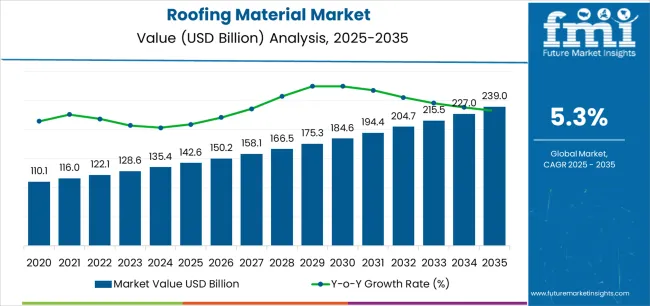
| Metric | Value |
|---|---|
| Estimated Value in (2025E) | USD 142.6 billion |
| Forecast Value in (2035F) | USD 238.4 billion |
| Forecast CAGR (2025 to 2035) | 5.3% |
Market expansion is being supported by the increasing global construction activity and the corresponding need for roofing solutions that can provide superior weather protection, thermal performance, and long-term durability while enabling cost-effective installation and maintenance across various residential, commercial, and industrial building applications. Modern construction developers and building owners are increasingly focused on implementing roofing systems that can withstand extreme weather conditions, reduce energy costs, and provide reliable performance throughout extended service life requirements. Roofing material's proven ability to deliver exceptional protection against environmental factors, enable energy efficiency improvements, and support building code compliance make them essential components for contemporary construction projects.
The growing emphasis on building envelope performance and lifecycle cost optimization is driving demand for roofing materials that can support enhanced insulation requirements, improve building energy efficiency, and enable reduced maintenance frequency. Contractors' preference for materials that combine installation efficiency with proven field performance and manufacturer support is creating opportunities for innovative roofing material implementations. The rising influence of climate resilience planning and extreme weather preparedness is also contributing to increased demand for roofing systems that can provide wind resistance, hail impact protection, and fire safety performance.
The roofing material market is poised for robust growth and transformation. As construction sectors across residential housing, commercial buildings, industrial facilities, and infrastructure seek roofing solutions that deliver exceptional weather protection, energy efficiency, and long-term performance, advanced roofing materials are gaining prominence not just as commodity building products but as strategic enablers of building performance optimization and climate adaptation.
Rising construction activity in Asia-Pacific and expanding re-roofing markets in North America and Europe amplify demand, while manufacturers are leveraging innovations in polymer-modified formulations, reflective coating technologies, and impact-resistant material development.
Pathways like cool roofing systems, lightweight composite materials, and solar-integrated solutions promise strong margin uplift, especially in high-value segments. Geographic expansion and vertical integration will capture volume, particularly where local manufacturing capabilities and distribution network density are critical. Building code requirements around energy efficiency, fire safety, wind resistance, and hail protection give structural support.
The market is segmented by material type, application, roof pitch, installation method, end-use, and region. By material type, the market is divided into asphalt shingles, metal roofing, clay & concrete tiles, slate, single-ply membranes, and others. By application, it covers pitched roofing, flat roofing, and curved roofing. By roof pitch, the market is segmented into steep slope and low slope. The installation method includes new installation and replacement/re-roofing. By end-use, it is categorized into residential, commercial, and industrial. By distribution channel, the market includes direct sales, distributors, and contractors. Regionally, the market is divided into North America, Europe, East Asia, South Asia & Pacific, Latin America, and the Middle East & Africa.
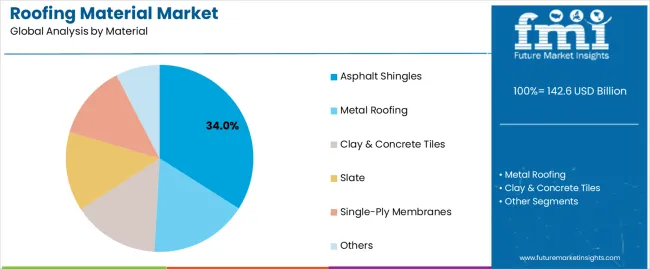
The asphalt shingles segment is projected to account for 34.0% of the roofing material market in 2025, reaffirming its position as the leading material category. Residential builders and commercial contractors increasingly utilize asphalt shingles for their cost-effectiveness, installation efficiency, extensive color and style variety, and proven field performance in applications ranging from single-family homes to multi-unit residential developments. Asphalt shingle technology's advanced polymer modification capabilities and consistent manufacturing quality directly address the construction industry requirements for reliable weather protection and aesthetic appeal in high-volume building environments.
This material segment forms the foundation of modern residential roofing operations, as it represents the roofing type with the greatest market penetration and established contractor familiarity across multiple climate zones and building types. Manufacturer investments in impact-resistant formulations and algae-resistant granule technologies continue to strengthen adoption among builders and property owners. With construction companies prioritizing installation speed and cost optimization, asphalt shingles align with both performance requirements and budget constraints, making them the central component of comprehensive residential roofing strategies.

Residential applications are projected to represent 57.0% of roofing material demand in 2025, underscoring their critical role as the primary consumer segment for roofing materials across single-family homes, townhouses, condominiums, and multi-family residential buildings. Homebuilders and residential contractors prefer diverse roofing materials for their ability to provide weather protection, enhance curb appeal, and deliver long-term value while meeting homeowner expectations for durability and warranty coverage. Positioned as essential building components for residential construction and renovation projects, roofing materials offer both functional protection and aesthetic contribution benefits.
The segment is supported by continuous innovation in color-fast granule technologies and the growing availability of extended warranty programs that enable competitive differentiation and homeowner confidence. Additionally, residential builders are investing in supply chain relationships to support large-scale development projects and quality consistency. As suburban expansion continues and residential renovation activity increases, residential applications will continue to dominate the end-use market while supporting advanced material technology utilization and product innovation strategies.
The roofing material market is advancing steadily due to increasing construction activity and growing adoption of energy-efficient roofing systems that provide superior thermal performance, weather resistance, and extended service life while enabling cost-effective installation across diverse residential and commercial building applications. However, the market faces challenges, including raw material price volatility, skilled labor shortages in roofing installation trades, and increasing competition from alternative roofing technologies. Innovation in impact-resistant formulations and reflective coating development continues to influence product development and market expansion patterns.
The growing adoption of cool roofing systems, reflective coatings, and high-albedo surface treatments is enabling roofing manufacturers to produce products with superior solar reflectance capabilities, reduced urban heat island contribution, and enhanced building energy efficiency characteristics. Advanced reflective technologies provide improved thermal performance while allowing more efficient cooling system operation and reduced peak energy demand across various building types and climate zones. Manufacturers are increasingly recognizing the competitive advantages of documented energy savings capabilities for product differentiation and building code compliance.
Modern roofing material producers are incorporating polymer modifiers, reinforced mat structures, and advanced granule technologies to enhance hail impact resistance, wind uplift performance, and fire safety ratings that enable insurance premium reductions, regulatory compliance, and value-added solutions to building owners in storm-prone regions. These technologies improve building resilience while enabling new market segments, including high-wind coastal applications, hail-zone residential construction, and wildfire-resistant building development. Advanced performance integration also allows manufacturers to support premium product positioning and specification development beyond traditional commodity roofing supply.
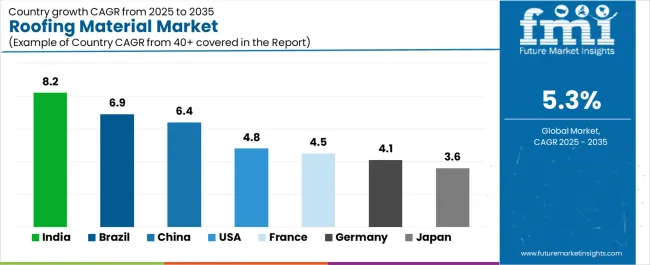
| Country | CAGR (2025-2035) |
|---|---|
| India | 8.2% |
| China | 6.4% |
| USA | 4.8% |
| Brazil | 6.9% |
| Germany | 4.1% |
| Japan | 3.6% |
| France | 4.5% |
The roofing material market is experiencing solid growth globally, with India leading at an 8.2% CAGR through 2035, driven by the expanding urban construction sector, growing housing development programs, and significant investment in residential and commercial infrastructure. China follows at 6.4%, supported by continued urbanization, increasing renovation activity in existing building stock, and growing emphasis on energy-efficient building envelope systems. The USA shows growth at 4.8%, emphasizing re-roofing market expansion and storm damage replacement demand. Brazil records 6.9%, focusing on residential construction growth and infrastructure development programs. Germany demonstrates 4.1% growth, prioritizing energy-efficient renovation and building modernization initiatives. Japan exhibits 3.6% growth, emphasizing disaster-resistant construction and seismic retrofit applications. France shows 4.5% growth, supported by residential renovation programs and commercial building development.
The report covers an in-depth analysis of 40+ countries; seven top-performing countries are highlighted below.
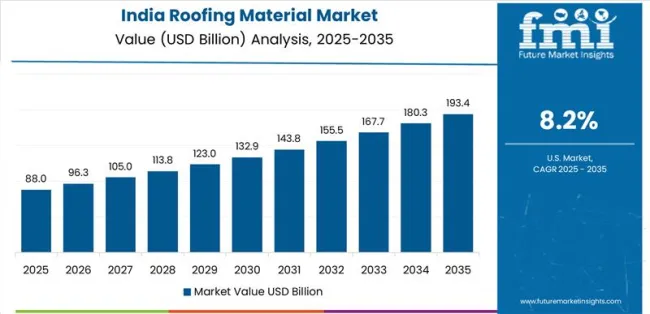
Revenue from roofing materials in India is projected to exhibit exceptional growth with a CAGR of 8.2% through 2035, driven by expanding urbanization and rapidly growing housing construction supported by government initiatives promoting affordable housing development and smart city infrastructure. The country's strong position in residential construction growth and increasing investment in commercial building development are creating substantial demand for diverse roofing material solutions. Major construction companies and material manufacturers are establishing comprehensive roofing material distribution capabilities to serve both urban development projects and rural housing programs.
Revenue from roofing materials in China is expanding at a CAGR of 6.4%, supported by the country's ongoing urbanization, growing renovation and retrofit activity, and increasing adoption of energy-efficient building technologies. The country's government initiatives promoting green building standards and growing middle-class housing demand are driving requirements for sophisticated roofing material capabilities. International suppliers and domestic manufacturers are establishing extensive production and distribution capabilities to address the growing demand for residential and commercial roofing products.
Revenue from roofing materials in the USA is expanding at a CAGR of 4.8%, supported by the country's large re-roofing and replacement market, strong emphasis on storm-resistant materials, and robust demand for high-performance roofing in residential and commercial applications. The nation's mature construction sector and aging building stock are driving sophisticated roofing material capabilities throughout the supply chain. Leading manufacturers and distribution networks are investing extensively in impact-resistant technologies and extended warranty programs to serve both new construction and replacement markets.
Revenue from roofing materials in Brazil is growing at a CAGR of 6.9%, driven by the country's expanding residential construction sector, growing middle-class housing demand, and increasing investment in affordable housing programs. Brazil's strong construction activity and commitment to infrastructure development are supporting demand for diverse roofing material solutions across multiple market segments. Manufacturers are establishing comprehensive production and distribution capabilities to serve the large domestic market and growing export opportunities within Latin America.
Revenue from roofing materials in Germany is expanding at a CAGR of 4.1%, supported by the country's building renovation leadership, advanced energy efficiency requirements, and strategic focus on green building technologies. Germany's engineering excellence and stringent building codes are driving demand for high-performance roofing materials in residential modernization, commercial renovation, and industrial facility upgrades. Manufacturers are investing in comprehensive technical support capabilities to serve both new construction projects and energy retrofit applications.
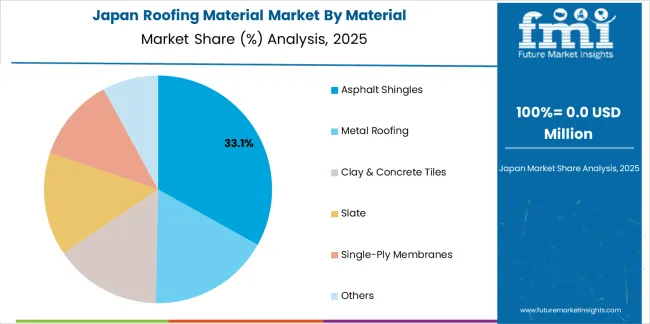
Revenue from roofing materials in Japan is growing at a CAGR of 3.6%, driven by the country's expertise in earthquake-resistant construction, emphasis on typhoon-rated roofing systems, and strong position in lightweight roofing technology development. Japan's established disaster preparedness capabilities and commitment to building resilience are supporting investment in advanced roofing technologies throughout major seismic zones. Industry leaders are establishing comprehensive testing and certification systems to serve domestic construction standards and export markets.
Revenue from roofing materials in France is expanding at a CAGR of 4.5%, supported by the country's residential renovation concentration, growing energy efficiency programs, and strategic position in traditional roofing material production including clay tiles and slate. France's heritage preservation requirements and integrated building renovation ecosystem are driving demand for both traditional and modern roofing materials in residential renovation, historic building restoration, and new construction applications. Leading manufacturers are investing in specialized capabilities to serve the stringent requirements of architectural preservation and energy efficiency regulations.
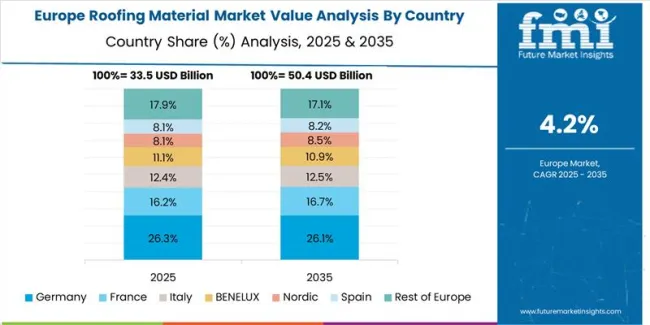
The roofing material market in Europe is projected to grow from USD 34.2 billion in 2025 to USD 58.7 billion by 2035, registering a CAGR of 5.5% over the forecast period. Germany is expected to maintain its leadership position with a 26.0% market share in 2025, declining slightly to 25.5% by 2035, supported by its strong residential renovation sector, advanced building energy efficiency requirements, and comprehensive construction industry serving diverse roofing material applications across Europe.
France follows with a 19.0% share in 2025, projected to reach 19.5% by 2035, driven by robust demand for roofing materials in residential renovation, heritage building restoration, and new construction projects, combined with established clay tile manufacturing capabilities and specialty roofing expertise. The United Kingdom holds a 17.0% share in 2025, expected to maintain 17.0% through 2035, supported by strong re-roofing activity and growing residential construction development. Italy commands a 15.0% share in 2025, projected to reach 15.2% by 2035, while Spain accounts for 11.0% in 2025, expected to reach 11.3% by 2035. The Netherlands maintains a 3.5% share in 2025, growing to 3.7% by 2035. The Rest of Europe region, including Nordic countries, Eastern Europe, Belgium, Switzerland, Austria, and Poland, is anticipated to gain momentum, expanding its collective share from 8.5% to 7.8% by 2035, attributed to increasing building renovation in Eastern Europe and growing cool roofing adoption in Nordic countries implementing advanced building performance programs.
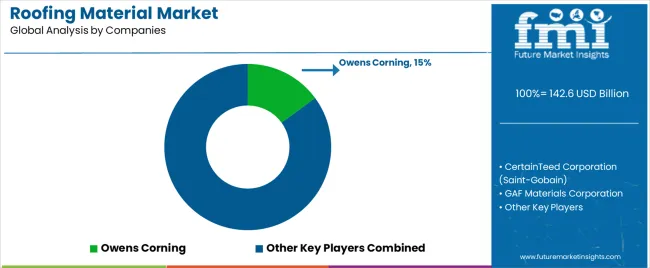
The roofing material market features 10–15 players with moderate concentration, where the top three companies collectively hold around 45–52% of global market share. Growth is driven by rising demand for energy-efficient buildings, increasing construction activities, and advancements in roofing technology. The leading company, Owens Corning, commands 15% of the market share, supported by its extensive portfolio of roofing materials, including asphalt shingles, synthetic underlayments, and insulation products. Competition centers on material durability, energy efficiency, sustainability, and innovation rather than price alone.
Market leaders such as Owens Corning, CertainTeed Corporation (Saint-Gobain), and GAF Materials Corporation maintain dominant positions by offering high-performance roofing systems with superior weather resistance, extended warranties, and a variety of design options. Their strengths lie in strong distribution networks, high-quality manufacturing, and innovation in sustainable roofing solutions.
Challenger companies including Kingspan Group, Braas Monier Building Group, and IKO Industries Ltd. focus on premium roofing materials, including metal roofing, synthetic tiles, and flat-roof solutions, emphasizing long lifespan, aesthetics, and advanced installation techniques.
Additional competition comes from Carlisle Companies Incorporated, Firestone Building Products Company, and TAMKO Building Products LLC, which enhance their presence through cost-effective solutions, roofing systems for commercial buildings, and strong regional manufacturing capabilities.
| Items | Values |
|---|---|
| Quantitative Units (2025) | USD 142.6 Billion |
| Material Type | Asphalt Shingles, Metal Roofing, Clay & Concrete Tiles, Slate, Single-Ply Membranes, Others |
| Application | Pitched Roofing, Flat Roofing, Curved Roofing |
| Roof Pitch | Steep Slope, Low Slope |
| Installation Method | New Installation, Replacement/Re-Roofing |
| End-Use | Residential, Commercial, Industrial |
| Distribution Channel | Direct Sales, Distributors, Contractors |
| Regions Covered | North America, Europe, East Asia, South Asia & Pacific, Latin America, Middle East & Africa |
| Countries Covered | United States, Canada, United Kingdom, Germany, France, China, Japan, South Korea, India, Brazil, Australia and 40+ countries |
| Key Companies Profiled | Owens Corning, CertainTeed Corporation (Saint-Gobain), GAF Materials Corporation, Kingspan Group, Braas Monier Building Group, IKO Industries Ltd., Carlisle Companies Incorporated, Firestone Building Products Company, TAMKO Building Products LLC, and Atlas Roofing Corporation |
| Additional Attributes | Dollar sales by material type and end-use category, regional demand trends, competitive landscape, technological advancements in impact resistance, cool roofing technologies, installation systems, and distribution network optimization |
The global roofing material market is estimated to be valued at USD 142.6 billion in 2025.
The market size for the roofing material market is projected to reach USD 238.4 billion by 2035.
The roofing material market is expected to grow at a 5.3% CAGR between 2025 and 2035.
The key product types in roofing material market are asphalt shingles, metal roofing, clay & concrete tiles, slate, single-ply membranes and others.
In terms of end use, residential segment to command 57.0% share in the roofing material market in 2025.






Our Research Products

The "Full Research Suite" delivers actionable market intel, deep dives on markets or technologies, so clients act faster, cut risk, and unlock growth.

The Leaderboard benchmarks and ranks top vendors, classifying them as Established Leaders, Leading Challengers, or Disruptors & Challengers.

Locates where complements amplify value and substitutes erode it, forecasting net impact by horizon

We deliver granular, decision-grade intel: market sizing, 5-year forecasts, pricing, adoption, usage, revenue, and operational KPIs—plus competitor tracking, regulation, and value chains—across 60 countries broadly.

Spot the shifts before they hit your P&L. We track inflection points, adoption curves, pricing moves, and ecosystem plays to show where demand is heading, why it is changing, and what to do next across high-growth markets and disruptive tech

Real-time reads of user behavior. We track shifting priorities, perceptions of today’s and next-gen services, and provider experience, then pace how fast tech moves from trial to adoption, blending buyer, consumer, and channel inputs with social signals (#WhySwitch, #UX).

Partner with our analyst team to build a custom report designed around your business priorities. From analysing market trends to assessing competitors or crafting bespoke datasets, we tailor insights to your needs.
Supplier Intelligence
Discovery & Profiling
Capacity & Footprint
Performance & Risk
Compliance & Governance
Commercial Readiness
Who Supplies Whom
Scorecards & Shortlists
Playbooks & Docs
Category Intelligence
Definition & Scope
Demand & Use Cases
Cost Drivers
Market Structure
Supply Chain Map
Trade & Policy
Operating Norms
Deliverables
Buyer Intelligence
Account Basics
Spend & Scope
Procurement Model
Vendor Requirements
Terms & Policies
Entry Strategy
Pain Points & Triggers
Outputs
Pricing Analysis
Benchmarks
Trends
Should-Cost
Indexation
Landed Cost
Commercial Terms
Deliverables
Brand Analysis
Positioning & Value Prop
Share & Presence
Customer Evidence
Go-to-Market
Digital & Reputation
Compliance & Trust
KPIs & Gaps
Outputs
Full Research Suite comprises of:
Market outlook & trends analysis
Interviews & case studies
Strategic recommendations
Vendor profiles & capabilities analysis
5-year forecasts
8 regions and 60+ country-level data splits
Market segment data splits
12 months of continuous data updates
DELIVERED AS:
PDF EXCEL ONLINE
Automotive Sound Proofing Material Market
Material Rack Correction Machine Market Size and Share Forecast Outlook 2025 to 2035
Roofing Anchors Market Size and Share Forecast Outlook 2025 to 2035
Material Shrinkage-reducing Agents Market Size and Share Forecast Outlook 2025 to 2035
Material Handling Integration Market Size and Share Forecast Outlook 2025 to 2035
Material-Based Hydrogen Energy Storage Market Size and Share Forecast Outlook 2025 to 2035
Roofing Underlay Market Size and Share Forecast Outlook 2025 to 2035
Roofing & Tile Underlayment Market Size and Share Forecast Outlook 2025 to 2035
Roofing Chemicals Market Size & Trends 2025 to 2035
Material Tester Market Growth – Trends & Forecast 2025 to 2035
Material Handling Equipment Market Growth - Trends & Forecast 2025 to 2035
Material Handling Monorails Market
Roofing Shingles Market
Biomaterial Tester Market Size and Share Forecast Outlook 2025 to 2035
Biomaterial In Surgical Mesh Market Size and Share Forecast Outlook 2025 to 2035
Biomaterial Market Analysis – Size, Share & Forecast 2025 to 2035
Metamaterial Market Size and Share Forecast Outlook 2025 to 2035
PET Material Packaging Market Size and Share Forecast Outlook 2025 to 2035
Metamaterial Absorbers Materials Market Size and Share Forecast Outlook 2025 to 2035
Nanomaterial Supercapacitors Market Size and Share Forecast Outlook 2025 to 2035

Thank you!
You will receive an email from our Business Development Manager. Please be sure to check your SPAM/JUNK folder too.
Chat With
MaRIA